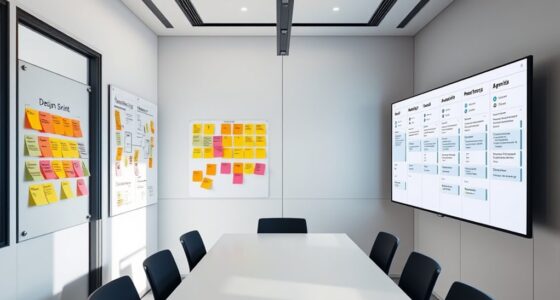To integrate service design deliverables into agile teams, focus on mapping every customer touchpoint to identify pain points and opportunities for improvement. Use continuous feedback loops from real interactions to guide quick iterations and prioritize features that boost customer satisfaction. By viewing products and services as interconnected, you can create seamless, engaging experiences that meet customer expectations consistently. If you want to explore how this approach can transform your projects, there’s more to discover below.
Key Takeaways
- Incorporate touchpoint maps to visualize customer interactions and identify improvement opportunities within agile workflows.
- Use service blueprints to align product features with overall customer experience goals.
- Embed customer feedback loops into sprint cycles to continuously refine both services and products.
- Prioritize features based on impact on customer satisfaction, ensuring service design considerations guide development.
- Foster cross-functional collaboration to ensure service delivery and product development work cohesively for seamless experiences.

Have you ever wondered how combining service and product can create a more seamless experience for you? When businesses integrate service design deliverables into agile teams, they aim to craft an experience that feels natural, intuitive, and tailored to your needs. At the core of this approach is understanding your customer journey—how you interact with the brand across different stages—and ensuring each touchpoint contributes positively to that experience. Touchpoint mapping becomes a crucial tool here, allowing teams to visualize every interaction you have with the company, whether it’s browsing a website, speaking to support, or receiving a product delivery. By clearly outlining these touchpoints, teams can identify pain points, gaps, and opportunities to enhance your overall experience.
Mapping every customer interaction helps teams identify pain points and improve your overall experience seamlessly.
In an agile environment, incorporating service design deliverables means that teams don’t treat products and services as separate entities but as interconnected parts of a unified customer experience. This integration requires a shift in mindset, where continuous feedback loops from customer interactions inform product development and service improvements. Touchpoint mapping serves as a bridge between these disciplines, helping teams see the full picture of your journey and prioritize features or adjustments that directly impact your satisfaction. For example, if you encounter friction during the onboarding process, mapping that touchpoint allows teams to quickly identify the root cause and iterate on solutions in rapid cycles.
The goal is to make your experience feel seamless, which demands a deep understanding of your needs and behaviors. By mapping out each point of contact, teams can ensure that your expectations are met consistently, whether you’re engaging through digital channels, customer support, or physical touchpoints. This proactive approach reduces friction, eliminates redundancies, and creates a more cohesive experience that aligns with your evolving preferences. It also fosters collaboration among cross-functional teams, as everyone has a shared understanding of your journey and can work together to optimize each interaction. Additionally, considering the cost of electric bikes and related accessories helps teams develop solutions that are not only user-friendly but also cost-effective for a wide range of customers.
Ultimately, integrating service design deliverables into agile teams transforms how businesses deliver value. It’s about being responsive to your feedback and continuously refining the experience. Touchpoint mapping is not just a static exercise; it’s an ongoing process that keeps your journey front and center. When done effectively, it results in a more consistent, engaging, and satisfying experience—one where your interactions with the product and service feel like parts of a well-orchestrated whole, rather than disjointed pieces. This integration ensures that every touchpoint contributes meaningfully to your overall satisfaction, making the entire customer journey smoother and more enjoyable.
Frequently Asked Questions
How Can Service Design Influence Product Development Timelines?
Service design can substantially influence product development timelines by mapping the customer journey and identifying pain points early. You engage stakeholders throughout, ensuring their insights shape features and priorities. This proactive approach minimizes rework and delays, streamlining the process. As a result, your team can deliver solutions faster, with a clear understanding of user needs, ultimately accelerating product delivery and enhancing overall customer satisfaction.
What Metrics Best Measure Success in Integrated Service and Product Teams?
You measure success through customer satisfaction, innovation rate, and team collaboration. Customer satisfaction reveals how well your team meets user needs, while a high innovation rate shows your ability to adapt and improve. Track these metrics regularly to identify strengths and areas for growth. By focusing on these, you guarantee your integrated service and product teams stay aligned, innovative, and customer-centric, driving continuous value and success in your projects.
How Do Team Roles Adapt When Merging Service Design Into Agile Workflows?
When merging service design into agile workflows, your team roles become more flexible to support cross-disciplinary collaboration. You adapt by encouraging role flexibility, allowing team members to take on diverse responsibilities beyond their usual scope. This fosters a shared understanding, enhances communication, and ensures that service design deliverables integrate smoothly. Emphasize open communication and shared goals to optimize collaboration across disciplines, ultimately delivering better, user-centered solutions.
What Are Common Challenges When Aligning Service Design With Product Goals?
Oh, the joys of aligning service design with product goals—like herding cats! You’ll face stakeholder engagement that’s more about lip service than action and resource allocation that’s constantly shifting like quicksand. These challenges can derail progress, making it hard to keep everyone on the same page. The trick? Clear communication, prioritizing stakeholder needs, and smart resource management to turn chaos into a cohesive, customer-centric journey.
How Can Feedback Loops Improve Both Service and Product Delivery?
Feedback loops enhance your service and product delivery by fostering customer empathy and refining the user journey. When you actively listen to user input, you can quickly identify pain points and adapt your solutions accordingly. This continuous cycle helps you stay aligned with customer needs, improve overall experience, and deliver value faster. Embracing feedback loops guarantees your team remains responsive, keeps the user journey smooth, and ultimately boosts satisfaction and loyalty.
Conclusion
By weaving service design into your agile team, you’re planting seeds that grow into a thriving garden of innovation. Each deliverable acts as an essential branch, supporting the whole tree of your product’s success. Embrace this integration as a compass guiding you through uncharted waters, leading to clearer direction and stronger connections with your users. When service and product unite, you create a symphony—an enduring harmony that transforms vision into reality.









